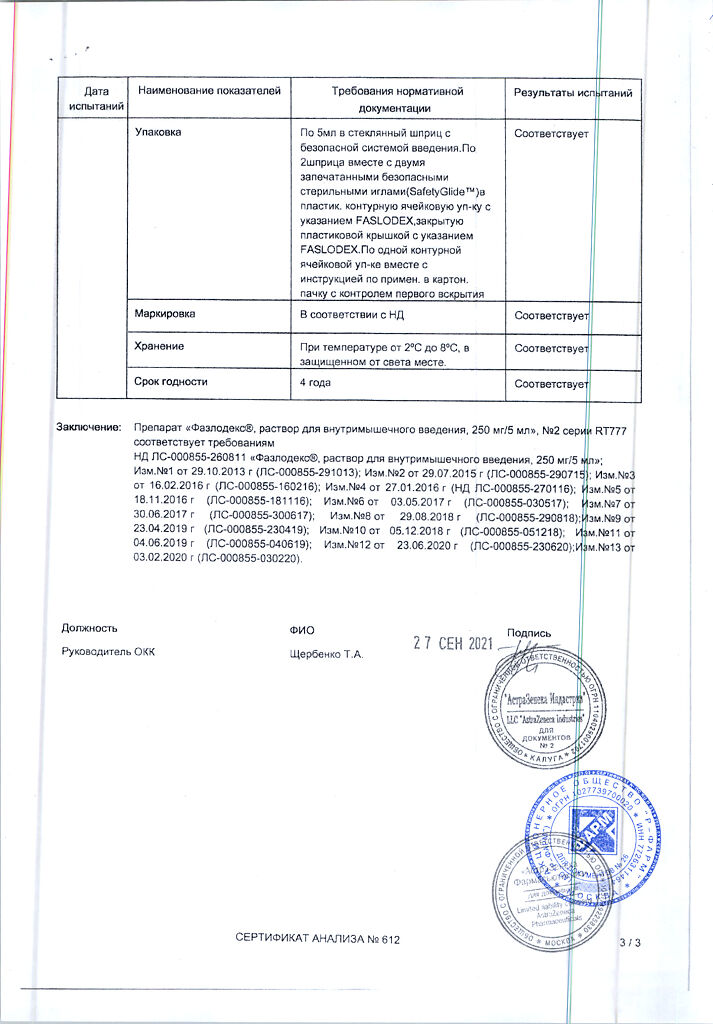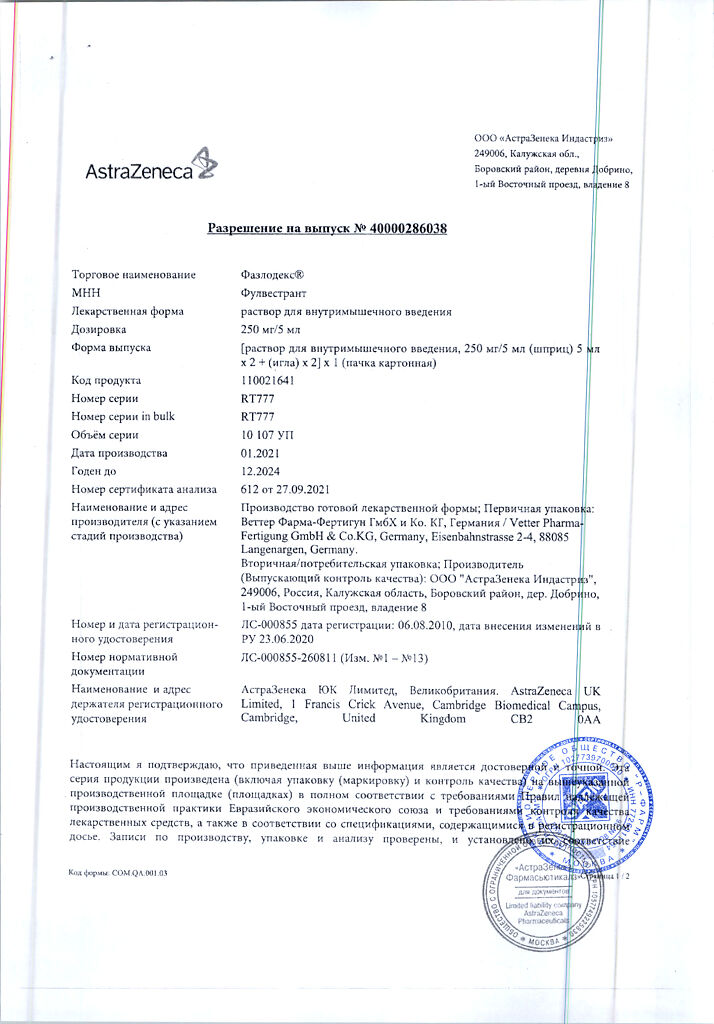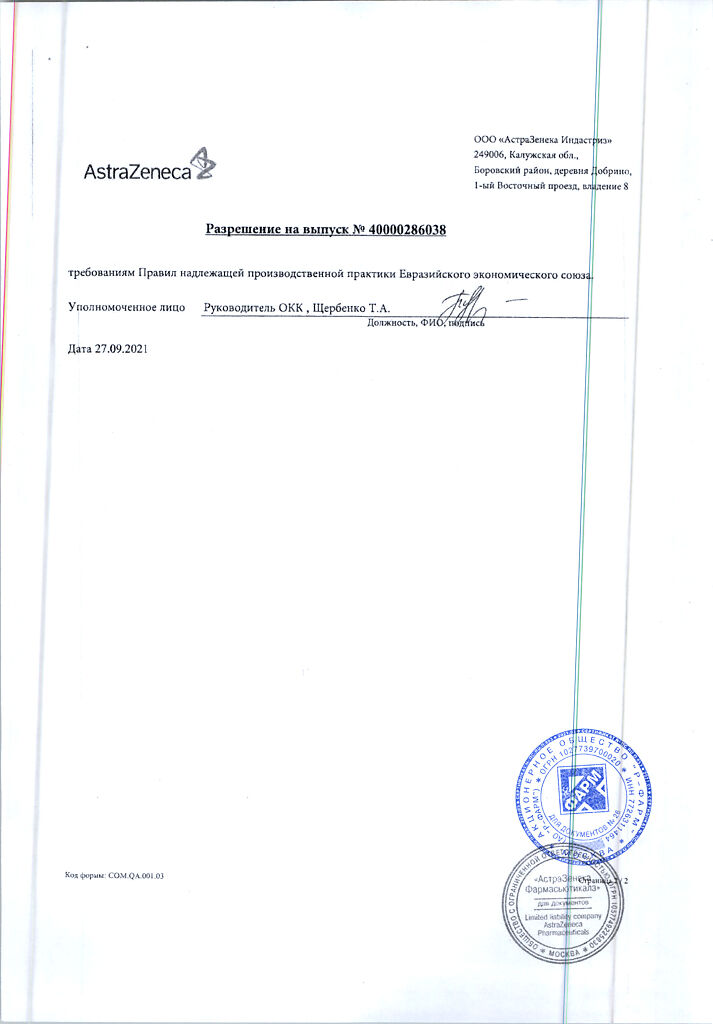No products in the cart.
Description
Fulvestrant is a competitive estrogen receptor antagonist. It is comparable to estradiol in the level of affinity to receptors. Fulvestrant blocks the trophic action of estrogen without showing its own estrogen-like activity. The mechanism of action is associated with inhibition of activity and degradation of estrogen receptors.
Fulvestrant also significantly reduces the expression of progesterone receptors. Fulvestrant has no stimulating effect on the endometrium in postmenopausal women. The effects of long-term fulvestrant therapy on the endothelium in postmenopausal women have not been established. There are also no data on endometrial morphology.
There are no data on the effects of long-term fulvestrant use on bone tissue.
Pharmacokinetics
Fulvestrant is slowly absorbed after intramuscular injection, reaching Cmax in plasma after approximately 7 days. With Fazlodex at a dose of 500 mg, the equilibrium state is reached within 1 month of therapy (AUC, 546 ng-day/mL, Cmax, 25.1 ng/mL, Cmin, 16.3 ng/mL). At equilibrium, the plasma content of fulvestrant fluctuates within relatively narrow limits – the maximum and minimum values differ by a factor of about 3.
After an intravenous injection, exposure is approximately proportional to the dose administered (in the dose range of 50 to 500 mg).
Fulvestrant is characterized by extensive and rapid distribution. The large apparent Vd (3 to 5 L/kg) at equilibrium concentration suggests predominantly extravascular distribution. Binding to plasma proteins is 99%. The major components of binding include fractions of LDLNP, LDLNP, and HDL. The role of the sex hormone binding globulin has not been established.
The metabolism of fulvestrant involves combinations of multiple potential biotransformation pathways similar to the metabolic mechanisms of endogenous steroids (include the metabolites 17-ketone, sulfone, 3-sulfate, 3- and 17-glucuronide). The identified metabolites are less active or equal in activity to fulvestrant. CYP 3A4 is the only isoenzyme in the P450 family that is involved in the oxidation of fulvestrant. However, it appears that in vivo biotransformation without P450 involvement predominates. Fulvestrant is mostly excreted in the feces, with less than 1% of the substance being excreted in the urine. The clearance of fulvestrant is (11±1.7) ml/min/kg, suggesting high hepatic extraction. T1/2 is 50 days.
Particular populations
The pharmacokinetic profile of fulvestrant is independent of age (range 33-89 years), body weight (40-127 kg), and race.
Renal dysfunction. Mild to moderate renal dysfunction has no clinically significant effect on the pharmacokinetics of fulvestrant.
Liver function abnormalities. A 2.5-fold increase in AUC was noted in patients with mild to moderate hepatic dysfunction (Child-Pugh grades A and B) when fulvestrant was administered once compared to healthy volunteers. No studies on the pharmacokinetics of fulvestrant in patients with severe hepatic impairment (Child-Pugh class C) have been conducted.
Indications
Indications
Local or disseminated estrogen receptor-positive breast cancer in postmenopausal women with progression after or on antiestrogen therapy.
Active ingredient
Active ingredient
Composition
Composition
1 syringe (5 ml of solution for intramuscular injection) contains:
the active ingredient:
fulvestrant 250 mg,
excipients:
Ethyl alcohol 96% – 100 mg/mL;
Benzyl alcohol – 100 mg/mL;
benzyl benzoate – 150 mg/ml;
castor oil – up to 5 ml.
How to take, the dosage
How to take, the dosage
Intramuscularly, by slow injection (over 1-2 minutes). The contents of 2 syringes are injected sequentially into the right and left buttock areas.
Adult female patients (including the elderly). The recommended dose is 500 mg once a month. In the 1st month of therapy: 500 mg 2 times a month (second injection 2 weeks after the 1st dose of the drug).
Children and adolescents. There are no data on safety and efficacy in children and adolescents.
Patients with impaired renal function.In cases of mild to moderate renal function impairment (creatinine Cl â¥30 ml/min) no dose adjustment is required. Safety and efficacy of the drug in patients with severe renal impairment (creatinine Cl
Patients with hepatic impairment. The use of the drug Fazlodex in patients with mild to moderate hepatic impairment does not require dose adjustment. However, the use of Fazlodex in this group of patients requires caution. The safety and efficacy of the drug in patients with severe hepatic impairment have not been established.
Interaction
Interaction
According to the results of clinical interaction studies with midazolam, fulvestrant does not inhibit CYP3A4 activity. In vitro data indicate that fulvestrant does not affect the activity of CYP1A2, 2C9, 2C19 and 2D6. Possible inhibition of CYP2A6, 2C8 and 2E1 activity has not been evaluated.
In clinical interaction studies with rifampicin (CYP3A4 inducer) and ketoconazole (CYP3A4 inhibitor) no clinically significant changes in fulvestrant clearance were found. Therefore, no dose adjustment is required when fulvestrant is prescribed in combination with CYP3A4 inducers or inhibitors.
Special Instructions
Special Instructions
Treatment with Fazlodex should only be done under the supervision of a physician experienced in the use of antitumor drugs.
Cautions are advised when using Fazlodex in patients with mild to moderate hepatic impairment and with severe renal impairment (Cl creatinine)
With regard to route of administration, caution is recommended when using Fazlodex in patients with bleeding tendency, thrombocytopenia or in patients taking anticoagulants.
Thromboembolism in women with advanced breast cancer is common. This should be taken into account when prescribing Fazlodex in patients at risk of thromboembolism.
The effects of long-term administration of fulvestrant on bone tissue have not been established. Given the mechanism of action of fulvestrant, the potential risk of osteoporosis cannot be excluded.
Faslodex should not be mixed with other drugs.
The effect on the ability to drive a car or perform work requiring increased speed of physical and mental reactions. This effect is insignificant. Patients with symptoms of asthenia should exercise caution when driving or operating other machinery.
Contraindications
Contraindications
With caution: impaired renal and hepatic function.
Side effects
Side effects
The observed adverse reactions are as follows.
Frequency determination of adverse reactions: very common (>10%); common (>1-â¤10%); rare (>0.1-â¤1%).
Digestive system disorders: often – nausea, vomiting, diarrhea, anorexia.
Cardiovascular system: very common – sensation of fever (“hot flashes”); common – thromboembolism.
Skin and skin appendages: often – rash.
Local reactions: often – transient pain, inflammatory reactions.
Urogenital system disorders: often – urinary tract infections; rarely – vaginal bleeding, vaginal candidiasis.
Others: often – headaches, asthenia, back pain; rarely – galactorrhea, hypersensitivity reactions (edema, urticaria).
Overdose
Overdose
In humans, there are no known cases of overdose. In animal studies with high doses of fulvestrant only effects directly or indirectly related to anti-estrogenic activity were observed.
Treatment: symptomatic therapy.
Additional information
| Weight | 0.059 kg |
|---|---|
| Shelf life | 4 years |
| Conditions of storage | In a light-protected place, at 2-8 °C |
| Manufacturer | Vetter Pharma-Fertigung GmbH & Co. |
| Medication form | solution |
| Brand | #Н/Д |
Related products
Buy Fazlodex, 250 mg/5 ml 5 ml syringes 2 pcs with delivery to USA, UK, Europe and over 120 other countries.



















